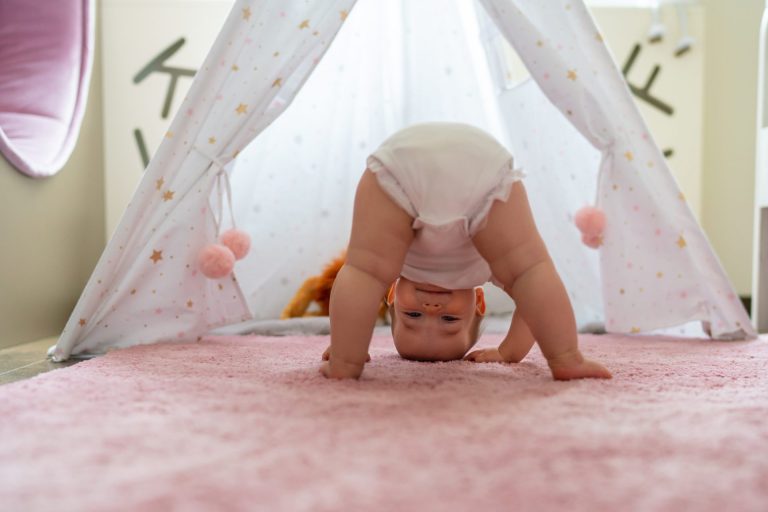The Myth of the Perfect Baby Timeline
When I first became a mom, I truly believed I had it all figured out. I had read every baby book, joined all the forums, downloaded the tracker apps, and knew the baby milestone timeline. I thought I could follow a clear roadmap: tummy time by three months, crawling by eight, walking by twelve. It felt reassuring to have that structure, like I could somehow stay one step ahead.
But then reality arrived, and my baby had her own plan. Low muscle tone meant she hated tummy time. She skipped crawling entirely, and she didn’t take her first steps until she was two. Every time we went to a check-up, I held my breath waiting to hear if she was “on track.” When she wasn’t, I felt like I had failed her. I worried constantly, wondering if I was doing something wrong, or if something was wrong with her.
Looking back, I realize I wasn’t just tracking her progress. I was measuring my worth as a mother, and that’s a heavy load to carry.
What Milestones Really Mean (and Don’t)
Milestones can be useful for awareness, but they’re not a universal rulebook. They were created to help caregivers notice when extra support might be needed, not to pressure parents or compare children.
According to the Centers for Disease Control and Prevention (CDC), milestone charts are based on average ages when children achieve certain skills. They aren’t deadlines. The CDC recently updated its developmental milestones to reflect more flexible ranges and make room for natural differences in how kids grow and learn.
| Skill | Average Age Range | What’s Normal |
|---|---|---|
| Rolling over | 3–6 months | Some babies skip it entirely |
| Crawling | 7–10 months | Some never crawl—they scoot or roll |
| Walking | 12–18 months | Many late walkers develop just fine |
| First words | 12–15 months | Gestures often come before words |
Every child has their own rhythm, and sometimes that rhythm doesn’t match the charts.
When “Late” Isn’t a Problem
My daughter was “late” on paper, but thriving in her own way. While I was worrying about walking, she was discovering how to communicate with her eyes and laughter. She was observant, creative, and curious. She spent hours exploring textures, sounds, and faces.
I wish I had known that development rarely moves in a straight line. A child who struggles in one area often shines in another.
-
A late walker might have incredible fine motor skills.
-
A speech-delayed child might communicate beautifully through gestures or expressions.
-
A cautious toddler might become a thoughtful, empathetic adult.
As Dr. Tovah Klein, child development expert and author of How Toddlers Thrive, says:
“Children grow best in relationships where they feel safe, seen, and supported—not rushed.”
That quote hit me hard the first time I read it. I realized that my job wasn’t to push her forward, but to make sure she felt loved right where she was.
The Power of Presence Over Progress
When I look back now, the things I remember most vividly have nothing to do with milestones. I remember her laughter echoing through the house when she figured out how to roll across the carpet. I remember the soft weight of her body on my chest during our quiet afternoon cuddles. I remember her little gasp of surprise when she noticed her reflection for the first time.
Those tiny, fleeting moments didn’t show up in any chart, but they were everything. They built connection, trust, and joy. They made us both feel grounded when the world felt uncertain.
It’s so easy to get caught up in what’s next. But the truth is, these are the moments that become your memories. These are the ones that stay.
Supporting Growth Without the Pressure
If you ever feel uneasy about your baby’s development, it’s always okay to talk to your pediatrician. Sometimes early support can make a world of difference, and reassurance from a trusted professional can quiet a lot of unnecessary worry.
But most of the time, your baby doesn’t need a fix. They just need time, space, and your encouragement.
Here are a few ways to focus on gentle support rather than comparison:
- Create low-pressure opportunities for movement and play.
- Celebrate effort, not perfection.
- Put away the milestone apps for a while.
- Take a break from comparison posts on social media.
- Savor the little things about this season of life.
If you’re craving a reliable resource, the American Academy of Pediatrics has a helpful guide to developmental milestones that emphasizes broad, healthy ranges instead of rigid rules.
What I’d Tell My Past Self
If I could go back, I would still look at milestones—but I would look at them with curiosity, not panic. I would give myself permission to slow down and trust that she was growing exactly how she was meant to.
I would spend less time refreshing milestone charts and more time watching her discover the world at her own pace. I’d hold her a little longer. I’d take more videos of the silly things she did. And I’d whisper to myself, “You’re both doing fine.”
Because milestones are just guideposts, not judgments. They don’t define your baby, and they certainly don’t define you. Your baby’s timeline is their own, and it’s perfect exactly as it is.
-
Milestones are helpful for awareness, but they don’t tell the whole story.
-
Every baby develops in their own rhythm.
-
Connection, safety, and joy matter more than comparison.
So the next time you feel anxious about where your baby “should” be, pause. Take a deep breath. Look at your little one and see all the ways they’re growing right now.
Because one day, you’ll realize these were the milestones that mattered most.

